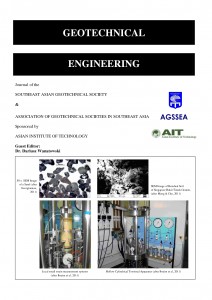Effect of Boundary Conditions on Shear Banding in True Triaxial Tests on Sand
Main Article Content
Abstract
Shear banding in true triaxial tests on sand have been studied to determine its effects on failure under three-dimensional conditions. Experiments have been performed on rectangular prismatic specimens with height-to-diameter ratio H/D = 2.47 and on cubical specimens with H/D = 1.0 to determine the influence of slenderness ratio and stiff versus soft boundaries on the results of such tests. The experiments show clear differences between the two types of tests: Shear banding in the tall specimens occurs with a sharp peak, while the short specimens show smoother stress-strain behavior near the peak, and all friction angles from the short specimens are 1-2 degrees higher than those from the tall specimens. The analysis of shear banding indicates that the critical hardening moduli are closer to zero for the short specimens than for the tall specimens. Indications are that experiments should be performed on tall specimens in which the shear banding occurs freely, while the short specimens impede and delay the development of shear bands.
Article Details

This work is licensed under a Creative Commons Attribution-NonCommercial-NoDerivatives 4.0 International License.
Copyright © 2019 Association of Geotechnical Societies in Southeast Asia (AGSSEA) - Southeast Asian Geotechnical Society (SEAGS).


